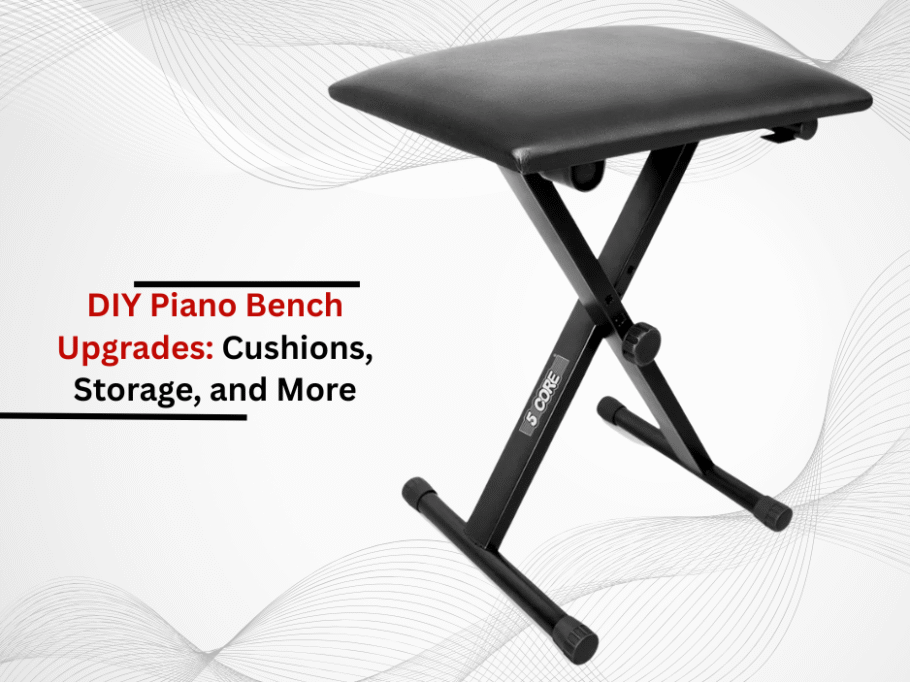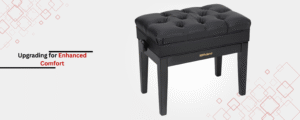An ergonomic piano bench is critical to help the user attain medium height in relation to the piano keyboard so that the posture is easy on the back, enabling the user to focus intently as he practices or plays. Even though solutions are available as off-the-shelf products, custom enhancements can be more functional and aesthetically appealing. The addition of concealed storage or the replacement of old worn-out cushions is possible by the use of do-it-yourself technology. In this article, we will discuss some techniques to improve comfort, durability, and organization at the same time, enabling musicians to take all their existing benches and transform them into ergonomic, multi-purpose tools. With these upgrades, novice and seasoned players alike will be able to optimize their seating experience.
Upgrading the Cushion for Enhanced Comfort
Materials and Tools Required:
To maximize the comfort provided by cushions, improving the existing foam seat on the bench is encouraged. Chairs provide great comfort and take great load off when relaxing with a good movie or sitting back and reading a good book. Therefore, selecting good, medium-firm gel foam, high-resilience foam, or memory foam would work best. Using a staple gun, scissors, measuring tape, and spray glue would optimize the grooves with the cushion covers. In case of adding more comfort and relief, linen and leather fabric cushions would serve great as they are breathable and tough, respectively.
Step-by-Step Process:
The old cushion is removed with care. The measurements are taken to ensure that the new foam is aligned with the existing ones on the bench. It is cut to fit the measurements. If multiple densities are used, the foam layers will be glued together. The fabric covering the cushion is pulled over the foam and secured at the bottom of the bench with staples or strong glue. In order to have a tidy look, decorative trim or piping can be added on the sides of many styles in most modern furniture
Pros and Cons:
Custom-made cushions offer relief while sitting down for long periods, particularly around the tailbone and thigh areas, as they provide targeted support. On the downside, if the cushion contains too much foam padding, it may lead to instability. Additionally, low-grade foam is prone to deterioration. To avoid overheating, breathable fabrics are recommended to be used on the custom cushions.
Adding Storage Solutions
Under-Bench Compartments:
With the use of a lightweight MDF board, a magnetic clasp can be used to secure the lid containing a hollow compartment for metronomes, sheet music, or tuning tools. Other precut plywood pieces can also be used as internal dividers for organization. The hinges will allow easy access to the bass.
Attachable Accessories:
For benches with no structural alterations, Velcro side pouches or clip-on music holders can offer storage that is both removable. These accessories are perfect for reducing clutter without changing the original look of the bench.
Considerations:
Additional storage solutions should integrate seamlessly with the existing architecture of the bench without obstructing its weight capacity or balance. Materials used should be selected very carefully in order to avoid injury, sharp corners, or visible fasteners, and to harmonize with the already existing design.
Additional Functional Upgrades
Non-Slip Pads or Grippers:
Sitting or adhesive grippers can be fixed to the legs of the benches to prevent slippage on hardwood floors. This is especially useful for active performers who use the bench or when the bench is placed on uneven surfaces.
Height Adjustment Modifications:
A fixed-height bench can be fitted with adjustable legs using threaded inserts or spacer blocks, but only if precision is maintained to avoid instability. Repurposing donor benches that feature pre-made adjustable mechanisms creates safer outcomes.
Aesthetic Enhancements:
A bench can be improved in appearance by adding decorative elements like stenciled designs and upholstery nailheads or by renishing the wood. Wooden surfaces are recommended to have protective sealants to avoid scratches and moisture.
Conclusion
Piano benches provide an affordable comfort upgrade. From stylish non-slip cushions to smart hidden storage, these features personalize and protect an existing bench’s longevity. Custom engineers like 5 Core, Donner, and Gleam fit a variety of professional preferences and ready-made solutions to consumer needs. As the creativity found in personal projects and commercial innovation becomes more intertwined, pianists are invited to navigate both worlds in their search for the ideal balance between design and usability.




